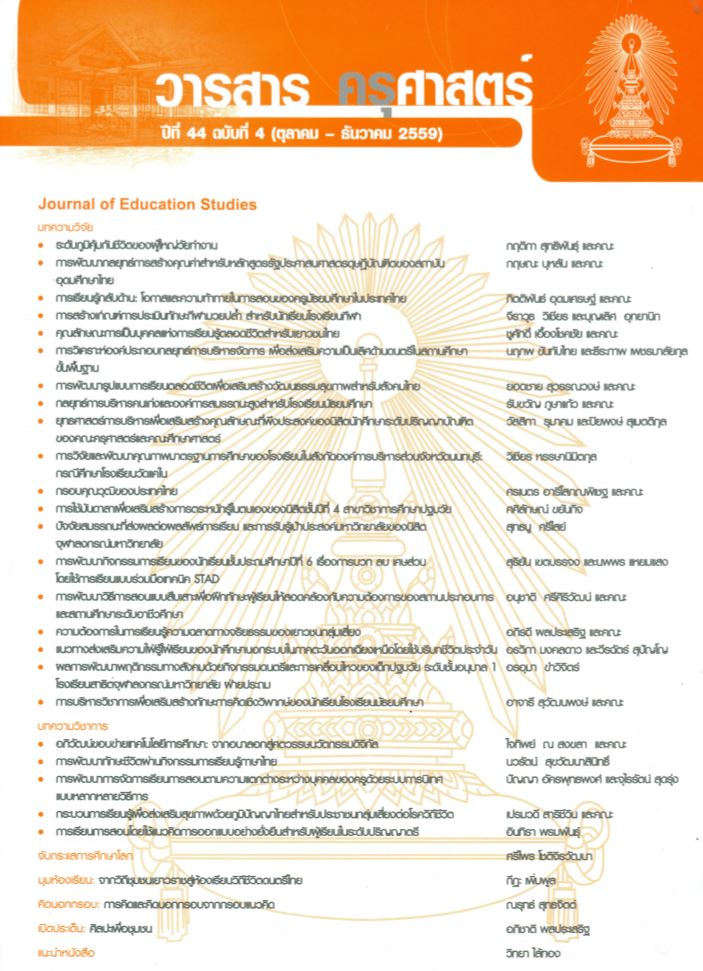การเรียนรู้กลับด้าน: โอกาสและความท้าทายในการสอนของครูมัธยมศึกษาในประเทศไทย
คำสำคัญ:
การเรียนรู้กลับด้าน, ห้องเรียนกลับด้าน, การออกแบบการเรียนการสอน, การเรียนรู้เชิงรุก, FLIPPED LEARNING, FLIPPED CLASSROOM, INSTRUCTIONAL DESIGN, ACTIVE LEARNINGบทคัดย่อ
การวิจัยนี้เป็นการวิจัยเชิงสำรวจโดยมีวัตถุประสงค์เพื่อศึกษาความคิดเห็นจากผู้เชี่ยวชาญและครูผู้สอนระดับมัธยมศึกษาจากทั่วทุกภาคของประเทศไทยเกี่ยวกับการออกแบบการจัดการเรียนการสอนแบบการเรียนรู้กลับด้าน และเสนอแนะแนวทางในการจัดการเรียนการสอนแบบการเรียนรู้กลับด้านในระดับมัธยมศึกษา โดยมีการดำเนินงาน 3 ขั้นตอนคือ 1) สัมภาษณ์ความคิดเห็นของผู้เชี่ยวชาญ 2) สอบถามความคิดเห็นของครูมัธยมศึกษา และ 3) นำเสนอแนวทางการจัดการเรียนการสอนแบบการเรียนรู้กลับด้าน กลุ่มตัวอย่างเป็นผู้เชี่ยวชาญจำนวน 6 คนและครูผู้สอนระดับมัธยมศึกษาจำนวน 370 คนโดยวิธีการสุ่มแบบแบ่งชั้น เครื่องมือที่ใช้คือ แบบสัมภาษณ์และแบบสอบถามความคิดเห็น ผลการวิจัยพบว่า ครูส่วนมากเห็นว่าการจัดการเรียนการสอบแบบการเรียนรู้กลับด้านมีความสำคัญ แต่ครูยังขาดความรู้ความเข้าใจและวิธีการที่เหมาะสมที่จะนำไปใช้ในการออกแบบการเรียนการสอน และแนวทางที่เหมาะสมในการพัฒนาการจัดเรียนการสอนแบบการเรียนรู้กลับด้านมีองค์ประกอบที่สำคัญ ได้แก่ 1) บริบทและสภาพแวดล้อม 2) เนื้อหา 3) กลยุทธ์การเรียนการสอน 4) สื่อและเทคโนโลยีในการเรียนการสอน 5) การประเมินการเรียนการสอน 6) บทบาทของครูผู้สอน และ 7) บทบาทของผู้เรียน
The purposes of this survey research were to study the opinions of experts and secondary school teachers in Thailand of Flipped Learning, and to propose a guideline for Flipped Learning instructional design for secondary schools in the country. The study was conducted using a mixed-method research divided into 3 phases: 1) interviewing the experts for their opinions, 2) surveying secondary school teachers’ opinions, and 3) proposing a Flipped Learning instructional design guideline. The sample group included 6 experts and 370 secondary school teachers in Thailand. They were selected by using the multi-stage sampling method. Interview forms and questionnaires were used to collect the data. The research findings indicated that the majority of teachers strongly agreed that Flipped Learning was crucial but teachers in Thailand still lacked knowledge and understanding to design such instruction due to the inadequacy of proper guidelines. The study proposed a guideline for Flipped Learning instructional design including: 1) learning context and environment, 2) contents, 3) Instructional strategies, 4) instructional media and technology, 5) evaluation, 6) teachers’ roles, and 7) students’ roles.




